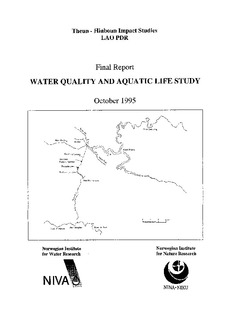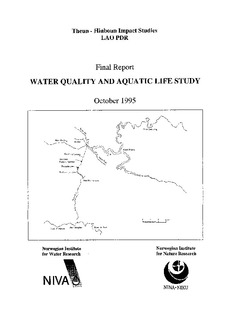| dc.contributor.author | Berge, D. | nb_NO |
| dc.contributor.author | Lien, L. | nb_NO |
| dc.contributor.author | Brettum, P. | nb_NO |
| dc.contributor.author | Rørslett, B. | nb_NO |
| dc.contributor.author | Knutzen, J. | nb_NO |
| dc.contributor.author | Bækken, T. | nb_NO |
| dc.contributor.author | Hvidsten, N.A. | nb_NO |
| dc.contributor.author | Roberts, T. | nb_NO |
| dc.contributor.other | Berge, D. - Project manager | nb_NO |
| dc.coverage.spatial | Laos Se-Asia | nb_NO |
| dc.date.accessioned | 2014-08-01T10:38:40Z | |
| dc.date.available | 2014-08-01T10:38:40Z | |
| dc.date.issued | 1995 | nb_NO |
| dc.identifier | 3360 | nb_NO |
| dc.identifier.isbn | 82-577-2892-6 | nb_NO |
| dc.identifier.issn | 1894-7948 | nb_NO |
| dc.identifier.uri | http://hdl.handle.net/11250/208568 | |
| dc.description.abstract | The present report summarises the results from the environmental impact assessment study on water quality and aquatic life in connection with the Theun Hinboun Hydropower Development Project, Lao PDR. The river Nam Theun, which is going to be dammed and partly diverted to Nam Hai/ Nam Hinboun, is a nutrient poor softwater river with low content of sediments. The proposed hydropower development will have considerable negative effects on the productivity of the Nam Theun and Nam Kading river, particularly the production of large edible fish species will decline. To avoid catastrophy in the downstream river fisheries a minimum release from the dam of 6-15 m³/s is neccessary. Likewise it is recommended to build a fish bypass through the dam to allow for fish migration. It is not recommended to establish a stocking programme introducing new fish species. In Nam Hai considerable erosion is expected to occur in the first period after the regulation. This may impose some smaller negative effects on the productivity of the receiving Nam Hinboun, which however, will be of transitional character. The new hydrological regime in Nam Hai can be positive to the aquatic life and fish production if the river is not allowed to be dry at any time after the regulation. A power house bypass should be built to allow for at least some flow during periods of power station maintenance. Some basins, or weirs should also be built in the tailrace system to reduce the fast water flow fluctuation in Nam Hai. This to prevent stranding of juvinile fishes. | nb_NO |
| dc.description.sponsorship | NORPLAN A/S | nb_NO |
| dc.publisher | Norsk institutt for vannforskning | nb_NO |
| dc.relation.ispartofseries | NIVA-rapport;3360 | nb_NO |
| dc.rights | Navngivelse-IkkeKommersiell-DelPåSammeVilkår 3.0 Norge | nb_NO |
| dc.rights.uri | http://creativecommons.org/licenses/by-nc-sa/3.0/no/ | nb_NO |
| dc.subject | eutrofi | nb_NO |
| dc.title | Final Report Water Quality and Aquatic Life Study Theun Hinboun Impact, Lao PDR | nb_NO |
| dc.type | Research report | nb_NO |
| dc.rights.holder | Norsk institutt for vannforskning/Norwegian institute for water research | nb_NO |
| dc.subject.nsi | VDP::Matematikk og naturvitenskap: 400 | nb_NO |
| dc.source.pagenumber | 58 | nb_NO |
| dc.subject.keyword | vannkraftutbygging | nb_NO |
| dc.subject.keyword | miljøkonsekvensanalyse vannkvalitet - fisk | nb_NO |
| dc.subject.keyword | environmental impact | nb_NO |
| dc.subject.keyword | water quality | nb_NO |
| dc.subject.keyword | hydropower | nb_NO |
| dc.subject.keyword | development | nb_NO |
| dc.subject.keyword | assessment | nb_NO |
| dc.subject.keyword | - | nb_NO |
| dc.subject.keyword | fish | nb_NO |
| dc.subject.keyword | biology | nb_NO |
| dc.relation.project | O-94261 | nb_NO |


